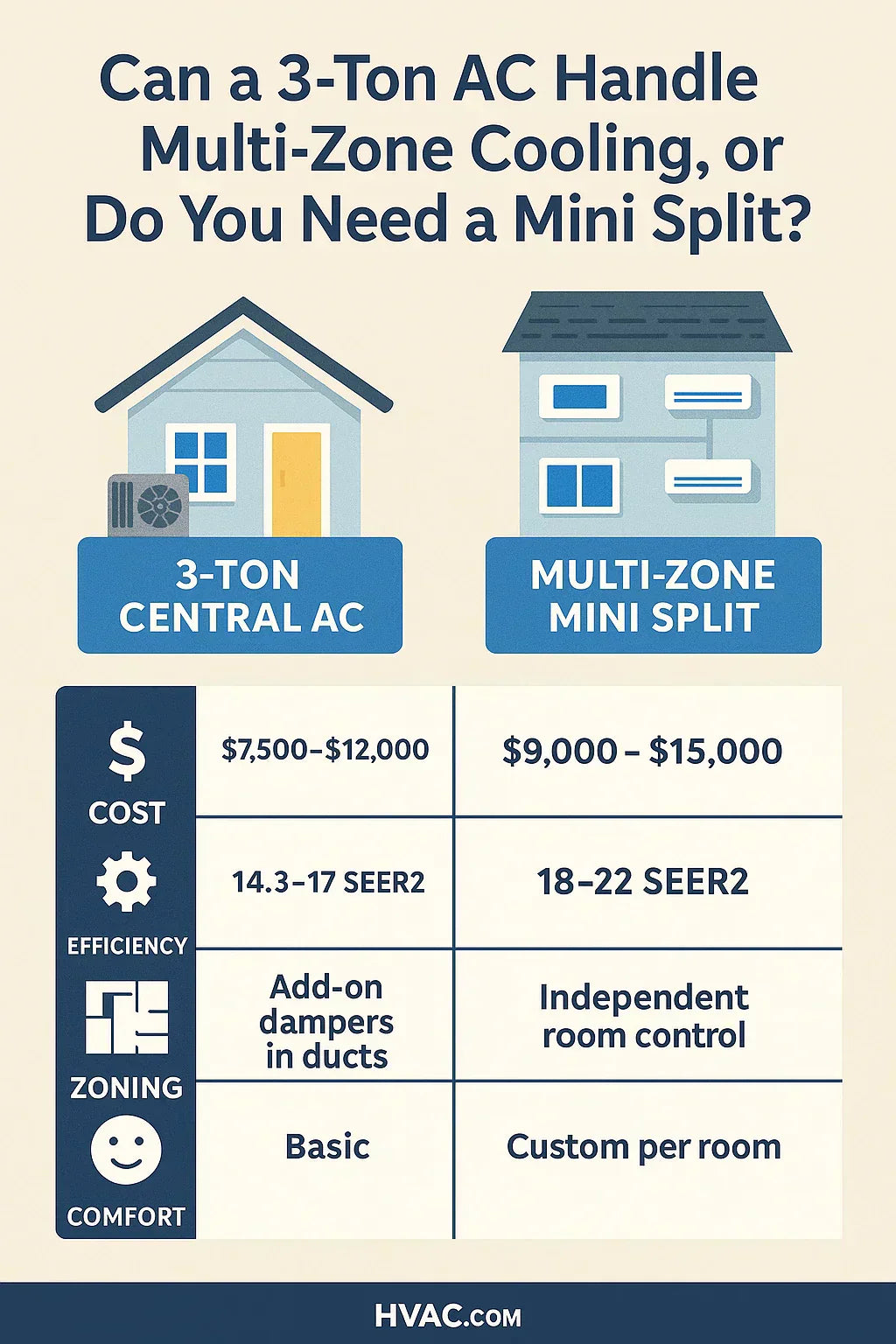📌 Introduction: Why Zoning Matters in 2025
Back when homes were smaller and layouts were simpler, a single AC unit could cool everything without much trouble. But in 2025, many houses are:
-
Two-story or split-level with hot upstairs rooms
-
Open-concept with fewer walls to contain airflow
-
Equipped with bonus rooms, finished basements, or sunrooms
That raises a big question: Is a 3-ton central AC system enough to handle multiple zones, or is a ductless mini split a smarter choice?
As someone who’s been through this decision, I’ll walk you through the real-world differences, costs, and comfort levels so you can see which system fits your home and budget.
🏠 How a Traditional 3-Ton AC Handles Zoning
A 3-ton AC system provides about 36,000 BTUs per hour, generally enough for homes around 1,500–2,000 square feet. But handling multiple zones is where things get tricky.
🔹 One Thermostat, One Zone
A standard 3-ton AC usually cools based on a single thermostat. That means:
-
Rooms closer to the thermostat often stay comfortable.
-
Rooms farther away (like upstairs bedrooms) may feel warmer.
🔹 Adding a Zoning System
You can add a zoning system to your ducts, which uses:
-
Motorized dampers to control airflow to different sections
-
Multiple thermostats tied into one control panel
This lets you, for example, send more cool air upstairs in the afternoon while reducing airflow to the main floor.
⚠️ Limitations
-
Zoning can only redistribute the cooling power you already have.
-
If your ducts leak, you’ll lose efficiency.
-
More moving parts = higher maintenance potential.
🔗 Energy.gov: Central AC Basics
❄️ What a Mini Split Brings to the Table
Mini splits, also known as ductless systems, are increasingly popular for multi-zone comfort.
🔹 How They Work
-
One outdoor unit connects to multiple indoor air handlers.
-
Each air handler controls a specific room or zone with its own thermostat.
🔹 Advantages
-
Customized comfort: Keep your bedroom cooler than your living room.
-
No duct losses: Saves 20–30% of energy vs. leaky duct systems
-
High efficiency: Many mini splits rate 18–22 SEER2 or higher.
-
Quiet operation: Indoor units are whisper-quiet compared to central AC blowers.
🔹 Disadvantages
-
Upfront cost: Multi-zone setups are more expensive than a single central AC.
-
Aesthetics: Wall-mounted units aren’t everyone’s favorite look.
-
Maintenance: Each air handler needs filter cleaning.
🔗 ENERGY STAR: Ductless Heating & Cooling
📊 Cost Comparison: Central AC vs. Mini Split
Here’s what you can expect to pay in 2025:
| Feature | 3-Ton Central AC w/ Zoning | Multi-Zone Mini Split |
|---|---|---|
| Installed Cost | $7,500–$12,000 | $9,000–$15,000 |
| Efficiency | 14.3–17 SEER2 | 18–22 SEER2 |
| Zoning | Add-on (duct dampers) | Built-in |
| Maintenance | Filter + duct cleaning | Filter cleaning + coil care |
| Best For | Homes w/ existing ducts | Homes w/o ducts or needing precision zoning |
🏘️ Which Works Best in Different Homes?
Let’s look at a few real-world examples:
🏡 One-Story Home (~1,800 sq ft)
-
Best Option: 3-ton central AC
-
Reason: Even cooling across one level; ducts easy to balance
🏠 Two-Story Home with Hot Upstairs
-
Option 1: Central AC with duct zoning → ~$9,000–$11,000
-
Option 2: Add a mini split upstairs for targeted cooling → ~$3,500 extra
🏢 Open-Concept Home (~2,200 sq ft)
-
Best Option: Two-stage 3-ton AC with zoning
-
Reason: Long run cycles for steady airflow across wide spaces
🏚️ Older Home with No Ducts
-
Best Option: Multi-zone mini split
-
Reason: Installing new ducts could cost $5,000–$10,000
🔧 Hybrid Approach: Best of Both Worlds
Some homeowners choose a hybrid setup:
-
A 3-ton central AC for the main living areas
-
A ductless mini split for problem zones like:
-
Sunrooms
-
Attics or lofts
-
Basements
-
Garage workshops
-
This way, you don’t oversize your central AC while still keeping tough rooms comfortable.
💰 Long-Term Efficiency & Savings
Central AC
-
Duct losses: 20–30% wasted if ducts are leaky
-
Best efficiency when ducts are insulated and sealed
Mini Split
-
No ducts = no losses
-
Higher upfront, but saves on utility bills (18–22 SEER2 vs. 14.3–17 SEER2 for central AC)
Example:
-
Central AC 16 SEER2 → ~$900/year in cooling
-
Mini Split 20 SEER2 → ~$720/year in cooling
-
Savings: ~$180/year → ~$2,700 over 15 years
✅ Mike’s Verdict
Here’s my homeowner’s take:
-
If your ducts are in good shape and your layout is simple, a 3-ton central AC with possible zoning will serve you well.
-
If you have tricky hot/cold spots, adding a zoning system or a supplemental mini split is smart.
-
If your home lacks ducts or you want maximum control, go with a multi-zone mini split.
-
Hybrid systems are often the sweet spot for tough layouts without overspending.
Bottom line: Don’t just look at upfront cost — factor in comfort, efficiency, and long-term savings.
In the next topic we will read more about: Maintenance Guide: Keeping Your 3-Ton AC & Air Handler Running Like New







